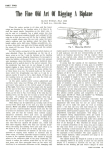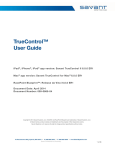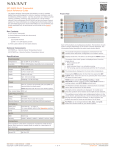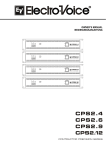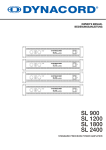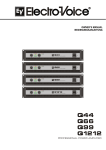Download Control 4 Multi Channel Amplifier16 Specifications
Transcript
AMP-1640-20/1640I-20 Quick Reference Guide The AMP-1640-20/1640I-20 Quick Reference Guide provides all the steps necessary to get the Savant AMP-1640 Multi-channel amplifier up and running. Note that this guide supports the following AMP-1640 units: • AMP-1640-20 (North America) • AMP-1640I-20 (International) The AMP-1640 is an ultra-efficient Class D power amplifier delivering 16 channels (8 zones) of reliable, affordable, feature-rich amplification rated at 40 watts per channel (WPC) at 8 ohms and 50 WPC at 4 ohms. The AMP-1640 is housed in a 3U rack-space metal enclosure. The AMP-1640 is an ideal eight-zone multi-room music system, as shown below, when paired with a Savant multi-room audio solution. A multi-room distributed audio solution is defined by how many listening zones it has. Within a listening zone you can only listen to one audio source (Internet Radio, CD, Music Server, etc.) at a time. 009-0377-00 Installation The AMP-1640 should be placed on a solid flat surface like a table or shelf or in an audio/video equipment rack. It should be placed upright so that its weight rests on the unit’s four feet (removable). Ventilation The AMP-1640 must be provided with adequate ventilation for proper cooling. When installing the AMP-1640 in a cabinet, be sure that the rear of the cabinet is open to adequate air to provide proper cooling. Be sure to leave a minimum of 3 inches clearance above and behind the amplifier and at least 2 inches on each side. If installed in a rack, active thermal management (such as rack fans) is recommended. An audio zone can consist of a single room or a group of rooms. When designing your distributed audio system, take into account who will use the system and when they will use it. For instance, you may wire your den for background music and your living room for surround sound. A multi-zone system allows different sources to be heard in each of the zones, simultaneously. The diagram below shows four audio sources connected to the Savant SmartAudio platform with 4 stereo preamps and 8 stereo outputs connected to the AMP-1640 for a 4 x 8 audio distribution solution. Caution: Do not block the ventilation holes on the sides and bottom of the AMP-1640. Speaker Connectivity When designing your system specify four to eight ohm speakers. Cable and Wire The AMP-1640 has multiple connections on the back panel. Savant recommends that you clearly label all the input cables and speaker wires. Label the cables and wires with their destination or source, rather than which terminal of the AMP-1640 they are connected to; it will be easier to reconfigure your system in the future. The AMP-1640 connects to your Savant multi-room audio solution via shielded line level audio cables with RCA phono plugs. Use high quality RCA cables to connect the multi-room audio to the amplifier inputs. The AMP-1640 connects to your speakers using 2-conductor speaker wire. For most applications, Savant recommends using 16 or 18 gauge wire. For wiring runs longer than 80 feet Savant recommends using 14-gauge wire. Each channel features a removable screw terminal speaker connection for easy installation in tight spaces. The terminal connector can accommodate up to 14-gauge stranded speaker wire. Speaker Wire Connections Caution: All speaker wire connections must be made with the amplifier off. Specifications Environmental Temperature Humidity 32° to 95° F (0° to 35° C) 10% to 80% RH (non-condensing) BTUs Physical 3900 BTUs per hour at maximum load Height Width 5.2 in/13.2 cm 17.3 in/44 cm Depth Weight 15 in/38.2 cm 35 lbs/16 kg Power Input Power Rated Current Draw Fuse Rating Caution: The amplifier must be off whenever you make changes to the input connections. 120 VAC, 60 Hz, 10A - Model AMP-1640-20 (N. America) 230 VAC, 50 Hz, 5A - Model AMP-1640I-20 (International) 10A (1150 max. wattage consumption) T15AH/250V (120V AREA) / T8AL/250V (230V AREA) IEC 320 power connector with 3-pole detachable power cord Rated Power Input Impedance 40 WPC at 8 ohms, 50 WPC at 4 ohms; (0.1% THD+N, 1kHz) 33k ohms Input Sensitivity Overall Voltage Gain 750mV for 40W at 8 ohms 27.5 dB Frequency Response Distortion, THD+N Bandwidth limited from 20Hz to 20kHz + 0.8 dB < 0.07% THD+N from 20Hz to 20kHz, All channels driven at 8 ohms > 90 dB 3 – 24V AC/DC Output Triggers Regulatory 12V DC (100mA) Safety and Emissions CSA NRTL/C FCC Part 15 Class B CE C-Tick Compliant RoHS Caution: Do not allow a single strand of wire to touch the amplifier chassis or another connector. Line Level Source Inputs Power Connection Operating Parameters Signal-to-Noise Ratio Input Triggers Bare Speaker Wire – Split the speaker wire insulation so that at least two inches of each conductor are separated. Strip 1/4 inch of insulation from the end of each conductor of the speaker wire. Twist the strands of speaker wire together and insert them into the appropriate screw terminal speaker connection. Savant recommends labeling all of the interconnecting cables to the sources they connect to (for example, CD players). Use quality audio patch cables with RCA phono plugs attached to the ends. Connect the sources by inserting the RCA plug into the amplifier’s RCA jacks. Connect the outputs from your sources to the inputs on the amplifier. Caution: Remember never connect a source or preamplifier’s input to the inputs of the AMP-1640 directly. AC Power Plug Connection The last connection made should be the AC power using a standard IEC 3-pole detachable power cord. Plug the attached power plug into a correctly grounded 120V 60 Hz (AMP-164020) or 230V 50 Hz (AMP-1640I-20) wall outlet. Front Panel Power LED The Power LED indicates that the AC power cord is plugged into a working AC power surge protected receptacle. When the Power LED is Red, the amplifier is in Standby mode, and when the Power LED is Green the amplifier is On. Power Button (Master) The Power button is the master power switch. No matter which turn-on mode you have selected, the Power button will turn off all circuitry—including the sensing circuitry. If you will be away and/or would like to reduce power consumption while you are away, set the Power button to Off (button is out). When you want to return to normal operation, set the Power button to On (button is in). Copyright 2011 Savant Systems LLC. SAVANT and RacePoint Blueprint are trademarks of Savant Systems LLC. Savant LLC reserves the right to change product specifications without notice. 770 Main Street, Osterville, MA 02655, Phone 508.683.2500, Fax 508.683.2600, http://www.savantav.com AMP-1640-20/1640I-20 Quick Reference Guide 009-0377-00 Protection Modes The AMP-1640 provides three protection modes. Note that the AMP-1640 does not shut down in a protection mode; only the faulty zone/channel is disabled. • Central potential protection mode (LED indication) The central potential protection mode is the only mode, which activates the Protection LEDs on the front panel. This mode is more commonly known as the DC potential protection mode and is designed to protect the connected speakers from any DC voltage that is output from the AMP-1640. When the central potential protection mode is activated, the LED for that respective channel will be turned on (Red). When a channel is in the central potential protection mode other active channels will remain operational unless they are in a protection mode. After the fault is fixed, the AMP-1640 will automatically restart the disabled zone/channel. • Speaker short protection mode (no LED indication) This mode will disable a zone/channel until the fault is fixed. After the fault is fixed, the AMP-1640 will automatically restart the disabled zone/channel. • Overload protection mode (no LED indication) This mode will disable a zone/channel until the fault is fixed. After the fault is fixed, the AMP-1640 will automatically restart the disabled zone/channel. Protection LEDs The eight zone LEDS indicate the status of each zone, or pair of channels when in the central potential protection mode. A Red LED indicates that the central potential protection mode has been enabled to protect a zone/channel (see above for description). External Trigger Connection Diagram - Daisy Chained Caution: Do not use a DC wall adapter. The long discharge time of the DC adapter’s filter capacitor will delay the turn-off of the amplifier. Note: The 3-24 AC/DC Voltage Trigger mode allows you to configure the amplifier to turn on automatically. 12V Trigger Control Output This terminal provides a 12V DC signal suitable for triggering an additional Savant AMP-1640 amplifier. This voltage is present only when the amplifier is active or on. When the amplifier turns off, the 12V signal is off. Gain The output level of each channel can be fined tuned using the gain control for each channel on the rear panel. Rear Panel Turn-on Mode Switch The rear panel turn-on mode switch determines when and how the amplifier will turn on. This switch provides two options for turning the AMP-1640 on and off. • Constant (manual turn-on via the front panel master Power button) • 3-24 AC/DC Voltage Trigger (External) Power Connection The power connection provides for a IEC 320 power connector with 3-pole detachable power cord. Constant – In this mode the front panel master Power button is in the On position. The amplifier is always on. The front panel master Power button operates the amplifier. 3 – 24V AC/DC Voltage Trigger – This mode provides for the following: • The master Power button on the front panel must be in the On position. • The amplifier is off when there is not a 3 - 24V AC or DC voltage applied to the voltage trigger input. • Once the sensing circuitry detects a voltage, all adjacent pairs of amplifier channels that are receiving an audio signal turn on. • Once the voltage stops, the sensing circuit instantly turns the amplifier off. • Voltage triggers can be supplied by Savant control platforms, some video projectors, or some surround sound processors. DC Voltage Signal Protection In the event a damaging DC signal becomes present on any of the speaker terminals, the DC protection circuit shuts down the specific zone or pair of channels and the associated red LED under Protection illuminates. To reset the amplifier you must set the front panel master Power switch to Off and then On. Cleaning and Maintenance The internal parts of the AMP-1640 are electronic and require no maintenance. Once a year it is appropriate to twist the RCA connectors on each input to remove any oxidation and improve conductivity. You can clean only with dry cloth. Do not use any spray-type, abrasive cleaners on the amplifier. Additional Documentation Additional documentation for the AMP-1640-20/1640I-20 is available at: http://www.savantav.com/ >Dealer Login > Knowledge Base > Products. • Refer to the GPIO Hardware Setup Guide for information on input and output triggers and GPIO input and outputs to Savant Controllers. • Refer to the RacePoint Blueprint Programming Guide on how to configure the AMP1640 into a Savant System. External Trigger Connection Diagram Copyright 2011 Savant Systems LLC. SAVANT and RacePoint Blueprint are trademarks of Savant Systems LLC. Savant LLC reserves the right to change product specifications without notice. 770 Main Street, Osterville, MA 02655, Phone 508.683.2500, Fax 508.683.2600, http://www.savantav.com


